

Civita Castellana Cathedral (Italian : Cattedrale di Santa Maria Maggiore or Santa Maria di Pozzano) is the cathedral of Civita Castellana, in central Italy. It is the episcopal seat of the Bishop of Civita Castellana.


Civita Castellana Cathedral (Italian : Cattedrale di Santa Maria Maggiore or Santa Maria di Pozzano) is the cathedral of Civita Castellana, in central Italy. It is the episcopal seat of the Bishop of Civita Castellana.
The edifice was built from around 1185, over a pre-existing church, and was completed with the construction of the portico in 1210. The latter saw the intervention of the Roman Cosmati family of architects and marble workers.
After centuries of decay, in the 18th century the church was totally restored and the interior was renovated in Baroque style. The two aisles were turned into side chapels, communicating with each other, thus keeping only a single nave. A plaque on the building's exterior commemorates Wolfgang Amadeus Mozart's sojourn in Civita Castellana on 17 July 1770: he also played the cathedral's organ at Mass of that day, a Sunday.
The church is preceded by a 13th-century portico, in whose architrave was once a mosaic frieze with gilded letters. Today only a few fragments of the latter can be seen. Two central piers support a rounded arch, in which is the writing "Gloria in excelsis Deo...", while another inscription at the top contains the name of the portico's designer, "IACOBUS CIVIS ROMANUS" ("James, citizen of Rome") and the date of execution (1210). The central and final piers of the portico are decorated with the marble symbols of the Four Evangelists, while in the middle of the arch is a lamb, symbolizing Jesus Christ.
The cathedral has three entrance gates. The central one is sided by four Corinthian columns, two of which stand on marble lions. Under the right lion is the representation of a child, a symbol of the faithful entering the church. The lunettes over the side gates have Cosmatesque mosaic decorations; the right lunette has also a representation of "Christ blessing ".
The cathedral has a Romanesque bell tower.
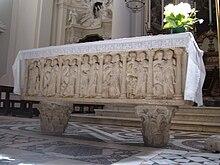
The church has a single nave, with side chapels which communicate with each other. The nave ends in a transept which precedes the raised sanctuary, under which is the crypt. In the transept's arms are two monumental Baroque altars: the right one is dedicated to the Madonna of the Light, and incorporates an 11th-century fresco; the left-hand altar is dedicated to the Madonna of the Rosary, and has a 16th-century canvas surrounded by 15 panels, depicting the mystery of the rosary.

The high altar, located in the sanctuary or presbytery is one of the most precious works of art in the church. It consists of a 4th-century Roman-Palaeochristian sarcophagus with seven niches which are decorated by biblical episodes. At the end of the presbytery, over the wooden choir, is a canvas by Pietro Nelli (Annunciation), while at the sides are two frescoes of the Resurrection of John and the Martyrdom of Saints John and Marcianus.
A door on the left side of the presbytery leads to the oratory of the Heart of the Virgin Mary , built as a chapel in the 14th century. This houses important medieval works including:
Under the presbytery is the crypt, with cross-vaults, dating to the 12th century but renewed later. It houses two Renaissance marble ciboria, originally in the presbytery but walled here during the 18th-century renovation works.
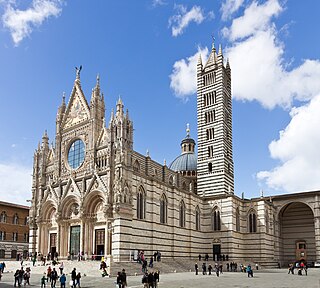
Siena Cathedral is a medieval church in Siena, Italy, dedicated from its earliest days as a Roman Catholic Marian church, and now dedicated to the Assumption of Mary.

Spoleto Cathedral is the cathedral of the Archdiocese of Spoleto-Norcia created in 1821, previously that of the diocese of Spoleto, and the principal church of the Umbrian city of Spoleto, in Italy. It is dedicated to the Assumption of the Blessed Virgin Mary.
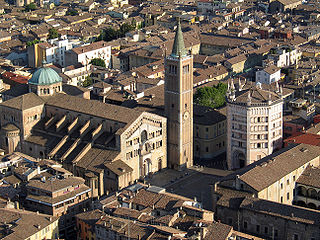
Parma Cathedral is a Roman Catholic cathedral in Parma, Emilia-Romagna (Italy), dedicated to the Assumption of the Blessed Virgin Mary. It is the episcopal seat of the Diocese of Parma. It is an important Italian Romanesque cathedral: the dome, in particular, is decorated by a highly influential illusionistic fresco by Renaissance painter Antonio da Correggio.
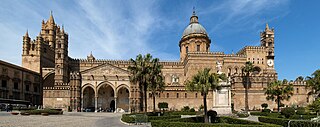
Palermo Cathedral is the cathedral church of the Roman Catholic Archdiocese of Palermo, located in Palermo, Sicily, southern Italy. It is dedicated to the Assumption of the Virgin Mary. As an architectural complex, it is characterized by the presence of different styles, due to a long history of additions, alterations and restorations, the last of which occurred in the 18th century.
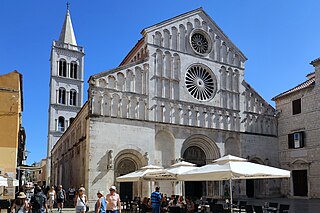
The Cathedral of St. Anastasia is the Roman Catholic cathedral of Zadar, Croatia, seat of the Archdiocese of Zadar, and the largest church in all of Dalmatia.

Prato Cathedral, or Cathedral of Saint Stephen, is a Roman Catholic cathedral in Prato, Tuscany, Central Italy, from 1954 the seat of the Bishop of Prato, having been previously, from 1653, a cathedral in the Diocese of Pistoia and Prato. It is dedicated to Saint Stephen, the first Christian martyr.
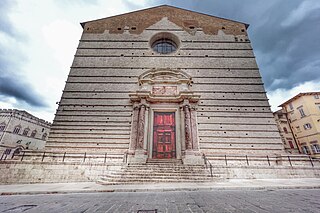
Perugia Cathedral, officially the Metropolitan Cathedral of St. Lawrence, is a Roman Catholic cathedral in Perugia, Umbria, central Italy, dedicated to Saint Lawrence. Formerly the seat of the bishops and archbishops of Perugia, it has been since 1986 the archiepiscopal seat of the Archdiocese of Perugia-Città della Pieve.

Padua Cathedral, or Basilica Cathedral of Saint Mary of the Assumption, is a Catholic church and minor basilica located on the east end of Piazza Duomo, adjacent to the bishop's palace in Padua, Veneto, Italy.

Pistoia Cathedral, or Cathedral of Saint Zeno is the main religious building of Pistoia, Tuscany, central Italy, located in the Piazza del Duomo in the centre of the city. It is the seat of the Bishop of Pistoia and is dedicated to Saint Zeno of Verona.

Pavia Cathedral is a church in Pavia, Italy, the largest in the city and seat of the Diocese of Pavia. The construction was begun in the 15th century on the site of two pre-existing Romanesque, "twin" cathedrals. The cathedral houses the remains of St. Sirus, first Bishop of Pavia, and a thorn purported to be from the Crown of Thorns worn by Christ. The marble facing of the exterior was never completed.
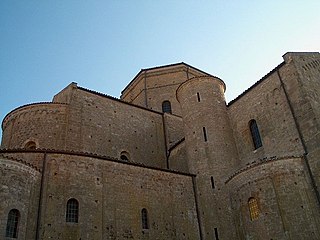
Acerenza Cathedral is a Roman Catholic cathedral dedicated to the Assumption of the Blessed Virgin Mary and to Saint Canius in the town of Acerenza, in the province of Potenza and the region of Basilicata, Italy. It is the seat of the Archbishop of Acerenza. It was declared a minor basilica in 1956.

Arezzo Cathedral is a Roman Catholic cathedral in the city of Arezzo in Tuscany, Italy. It is located on the site of a pre-existing Palaeo-Christian church and, perhaps, of the ancient city's acropolis.

Civita Castellana is a town and comune in the province of Viterbo, 65 kilometres (40 mi) north of Rome.

Ancona Cathedral is a Roman Catholic cathedral in Ancona, central Italy, dedicated to Saint Cyriacus. It is the seat of the Archbishop of Ancona. The building is an example of mixed Romanesque-Byzantine and Gothic elements, and stands on the site of the former acropolis of the Greek city, the Guasco hill which overlooks Ancona and its gulf.

Volterra Cathedral is a Roman Catholic cathedral in Volterra, Italy, dedicated to the Assumption of the Virgin Mary. It is the seat of the bishop of Volterra.

Terni Cathedral is a Roman Catholic cathedral in Terni, Umbria, Italy, and the seat of the bishop of Terni-Narni-Amelia. It is dedicated to the Assumption of the Virgin Mary.

Avellino Cathedral is a Roman Catholic cathedral dedicated to the Assumption of the Virgin Mary and Saint Modestinus in Avellino, Campania, Italy. It is the seat of the bishops of Avellino.
The Collegiate Church of Santa Maria Assunta is a Gothic church located in Sermoneta, southern Lazio, Italy. The church is often referred to as a cathedral ("cattedrale") but has never been the seat of a bishop. It is dedicated to the Assumption of the Virgin Mary.

Fano Cathedral is the principal church of Fano, Marche, Italy. Originally the seat of the bishop of Fano, since 1986 it has been the episcopal seat of the Diocese of Fano-Fossombrone-Cagli-Pergola. In January 1953 Pope Pius XII elevated it to the rank of a basilica minor.

Gaeta Cathedral, more formally the Cathedral of Saints Erasmus and Marcian and St. Mary of the Assumption, is the most important place of Catholic worship in Gaeta, Italy, mother church of the archdiocese of the same name and seat of the parish of Mary Most Holy Assumed into Heaven.